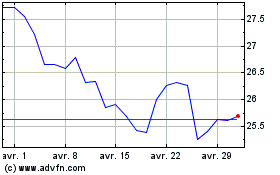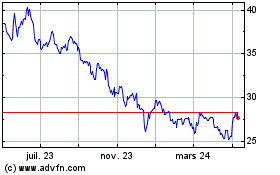Drug Prices to Be Disclosed in TV Ads Soon
08 Mai 2019 - 7:38PM
Dow Jones News
By Stephanie Armour
The Trump administration completed its rule requiring drugmakers
to include list prices for most drugs in television ads, pushing
ahead with efforts to improve transparency in health-care costs
despite opposition from pharmaceutical companies.
The administration's new rule, set to take effect this summer,
applies to direct-to-consumer TV advertisements for prescription
drugs covered by Medicare or Medicaid. Drugmakers must include the
wholesale acquisition cost, or list price, if it is equal to or
greater than $35 for a month's supply, and must post the list price
at the end of the ad in a way that it can be seen clearly.
In 2017, over $5.5 billion was spent on prescription-drug
advertising, including nearly $4.2 billion on TV ads. Commonly
advertised drugs include AbbVie Inc.'s Humira, which has a list
price of more than $5,000 a month, along with Pfizer Inc.'s Lyrica,
which costs $468 a month, according to data provided in the
rule.
The rule will go into effect 60 days after it posts in the
Federal Register, which is expected to occur Friday.
Drugmakers have opposed the mandate, saying the rule could
improperly limit free speech and that providing only the list price
would confuse and mislead consumers who might think they have to
pay more than they actually would. The list price is the figure
initially set by the drugmaker, but it is different than what
consumers generally pay, because it doesn't take into account
rebates, discounts and insurance payments.
"While we are still reviewing the administration's rule, we
believe there are operational challenges, particularly the 60-day
implementation timeframe, and think the final rule raises First
Amendment and statutory concerns," said Stephen Ubl, president and
chief executive of the Pharmaceutical Research and Manufacturers of
America, or PhRMA, a trade group for the industry.
The administration argued that list prices matter to patients,
especially consumers with high deductibles who often must pay the
full amount. The U.S., one of the few countries to allow TV ads for
drugs, currently requires ads to disclose side effects and other
information.
"Requiring the inclusion of drugs' list prices in TV ads is the
single most significant step any administration has taken toward a
simple commitment: American patients deserve to know the prices of
the healthcare they receive," said Health and Human Services
Secretary Alex Azar, in a written statement. "We think it is a
fundamental right to know" the list price of the drug.
Matt Eyles, president and chief executive of America's Health
Insurance Plans, a trade group for the industry, said "greater
transparency from manufacturers into drug prices -- how drugmakers
set those prices, and why they increase prices on the exact same
product year after year -- is essential to bringing down drug
prices."
The rule issued Wednesday by HHS is part of a broader effort
launched by the White House in May 2018 to combat rising drug
prices, an issue many consumers rank as a top health-care concern
in polls.
The administration has pursued a proposal to tackle drug rebates
that go to middlemen, which could halt billions of dollars in
discounts that drugmakers give insurers and companies such as CVS
Health Corp. and UnitedHealth Group Inc. that administer Medicare
prescription plans. The Food and Drug Administration has also
sharply increased the number of generic drugs approved over the
past year.
But the administration has also faced criticism for not taking
bolder steps, such as allowing for the importation of drugs from
other countries such as Canada. Congressional Democrats have also
said the efforts fall short of mandating the negotiation of drug
prices in Medicare's prescription drug benefit.
The pharmaceutical industry has said it is being made a
scapegoat for other issues that are driving drug costs.
Prescription drug costs are projected to increase by an average of
6.3% annually from 2017 through 2026, according to federal data
released in February.
Some drugmakers have begun listing prices before the rule was
completed. PhRMA last year said major drugmakers would voluntarily
include price-related information in TV ads by directing consumers
to websites where they can find information on list prices and
costs.
The rule's total administrative costs for drugmakers are
expected to be about $5.2 million in 2020 and about $2.5 million in
subsequent years. Larger drugmakers will experience higher
costs.
Write to Stephanie Armour at stephanie.armour@wsj.com
(END) Dow Jones Newswires
May 08, 2019 13:23 ET (17:23 GMT)
Copyright (c) 2019 Dow Jones & Company, Inc.
Pfizer (NYSE:PFE)
Graphique Historique de l'Action
De Avr 2024 à Mai 2024

Pfizer (NYSE:PFE)
Graphique Historique de l'Action
De Mai 2023 à Mai 2024
